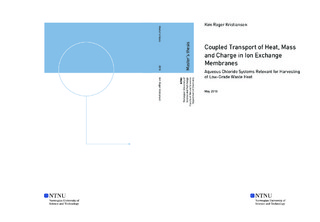| dc.description.abstract | In this thesis, the theory of classical non-equilibrium thermodynamics is used as a tool for the analysis of transport processes in ion exchange membranes, and for designing experiments for the determination of coupling coefficients quantifying the degree of correlation between transport of heat, mass, and charge under operation. \\
Chapter 1, along with appendix A, give a brief account of the theoretical derivations and assumptions leading to the constitutive relations and an expression for the local entropy production, which are later applied to the special cases considered in chapters 2 and 3.
Chapter 2, along with appendix B, address the case of coupled transport of water and charge carriers across a selection of ion exchange membranes in a variety of aqueous alkali and alkali earth chloride solutions. Appendix B covers the derivation of the regression model needed for analyzing the measured data, which is also a generalization of previous work. It is generally found that the transference coefficient of water, defined as the average number of water molecules transported per unit of elementary charge transferred, decreases in magnitude with the size of the charge carrier. The sign of this coefficient indicates that for all membranes considered, the net transfer of water is in the same direction as the transfer of charge carrier, and correlations are confirmed between water transport and water content of the membranes, and also between water transport and the mass-corrected solvation entropy in external solution. The water permeability, defined as the volume flux of water per unit of pressure difference across the membrane, was also calculated by using the regression model. Although the errors in the permeability estimates are large, likely due to membrane deformation during measurements, the permeability is significantly reduced as the valence of the charge carrier is increased.
In chapter 3, we consider a non-isothermal cell in order to measure the thermoelectric properties of ion exchange membranes. A flow cell was designed and built specifically for these experiments. In order to combat the phenomenon of temperature polarization, the cell potential is measured with membranes stacked together in order to increase the effective membrane thickness. A non-linear model is developed in order to find the Seebeck coefficient, defined as the ratio of cell potential to temperature difference in the stationary state, as a function of the stack thickness. This model is then used for assessing the stack thickness required to eliminate temperature polarization, and to extrapolate to limiting values. The measured values of the Seebeck coefficients are then combined with the water transference coefficients from chapter 2 in order to calculate the transported entropies of the principal charge carriers in each membrane. The results indicate that in both cases considered here, heat is transported along with the charge carrier. The Thomson effect, which is a heat effect due to the temperature dependence of the entropy transfer, was found to be insignificant for all experimental conditions that were considered.
In chapter 4, we present conclusions and perspectives for further work, along with suggestions for improving the experimental techniques. The results of chapter 3 are used for discussing the possibility of enhancing the efficiency of salt power plants by using them as thermoelectric generators. Preliminary estimates suggest that the efficiency of salt power plants can be substantially improved by means of this concept. | |

